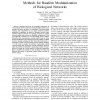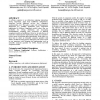208 search results - page 18 / 42 » Detecting Feature Interactions: How Many Components Do We Ne... |
BIBE
2006
IEEE
14 years 2 months ago
2006
IEEE
— Biological networks are formalized summaries of our knowledge about interactions among biological system components, like genes, proteins, or metabolites. From their global top...
EDBT
2009
ACM
14 years 9 days ago
2009
ACM
Many Web applications are based on dynamic interactions between Web components exchanging flows of information. Such a situation arises for instance in mashup systems or when moni...
BMCBI
2006
13 years 8 months ago
2006
The protein-protein interaction networks of even well-studied model organisms are sketchy at best, highlighting the continued need for computational methods to help direct experim...
EDO
2005
Springer
14 years 2 months ago
2005
Springer
re connector is an abstraction capturing interactions among components. Apart from middleware independence, connectors provide additional services (e.g., adaptation, synchronizati...
IROS
2006
IEEE
14 years 2 months ago
2006
IEEE
— Robots that can interact naturally with humans require the integration and coordination of many different components with heavy computational demands. We argue that an architec...




